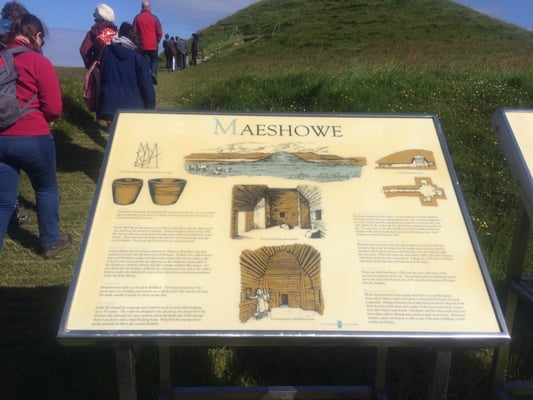David J.
Yelp
Maeshowe looks like little more than a grassy mound from the nearby main road. But it is the finest chambered tomb in northern Europe - bar none. Over 5,000 years old, it predates the oldest of the Pyramids in Egypt.
The tomb itself is accessed via a long, low and narrow tunnel, 14m long and just 1.4m high. This enters the large central chamber, with is 4.5m square and about 4m high, the walls of which taper gently to the roof, with butresses at each corner. Three further chambers open off this main chamber, each with a right-angled dog-leg.
The interior architecture of the tomb is stunning. The walls were built of massive blocks of sandstone, beautifully prepared and laid with great care to form an sublime space. The tapering and accuracy of the fit of the stones cannot fail to impress. It also represents a phenomenal feat of engineering, as the individual blocks weigh up to three tonnes. It would be a challenge now, let alone 5000 years ago. The acoustics are also unique - giving an other-worldly sound, with patches of loud and quiet noise, suggesting this may have formed part of rituals performed within.
Another famous feature is a series of 30 different Viking runes dating from the 12th century. Left by Vikings who took shelter from a storm here returning from the crusades, it is one of the largest collection in existence, and is accompanied by drawings of dragon, a walrus and a serpent. These are explained in detail at: http://www.orkneyjar.com/history/maeshowe/maeshrunes.htm
This incursion (or incursions) is also reported in the Orkneyinga Saga. It is amazing to think that the 12th century Vikings are more contemporaneous with us than with the original builders.
There is some speculation that the tomb may have been reused as a burial chamber in the Viking period.
The entrance passage is aligned with the winter solstice, so that the sun shines directly into the chamber on the shortest day. This, together with the sparsity of artefacts found when the tomb was first excavated in 1861, suggest it may have had a ritual use beyond being a burial site. For many years, the passage was blocked, and an entrance had been broken through the roof. The roof, and the mound above, has now been restored.
The site is open daily, but visitor numbers are restricted due to the confined space, so tickets must be reserved in advance, either by telephone or the web-site, and are valid for a specific timed period. You report to the visitor information centre at Tormiston Mill, where there is an display giving information about the tomb. The narrow passage entrance is not too hard to scramble along, but may not suit those of a claustrophobic nature.













